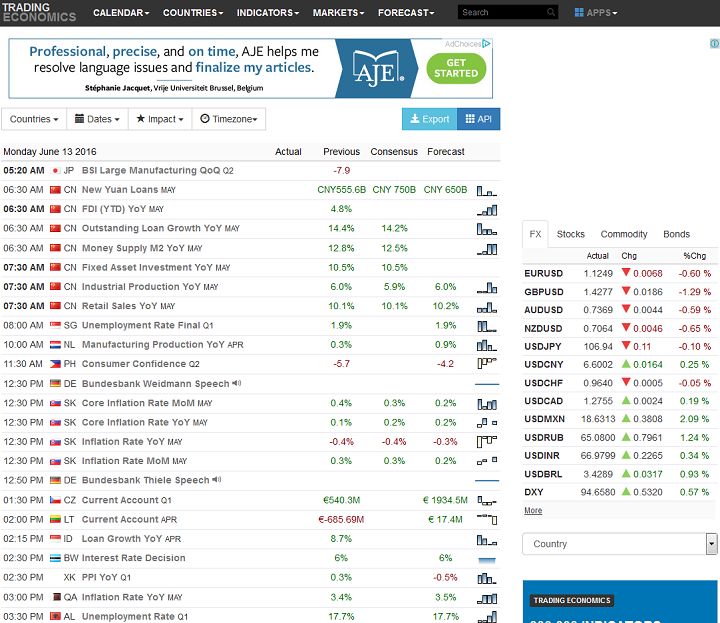
Contents
- 1 The List
-
2 Interface
- 2.1 Appearance
- 2.2 Legend
- 2.3 Images/Currency Codes
- 2.4 Additional Details
- 2.5 Charts
- 2.6 Revisions
- 2.7 Filters
- 2.8 Timezone
- 2.9 Time Browsing
- 2.10 Week Beginning
- 2.11 Self-Updating
- 2.12 Mobile-Friendly
- 2.13 Delays
- 2.14 Notification
- 3 Loading Speed
- 4 Number of Events
- 5 Forecast Accuracy and Similarities
- 6 Translations
- 7 Extra Features
- 8 Exporting and Printing
- 9 Summary
Update 2017-09-15: The review has been updated to provide current information on the calendars’ page load speed, number of events, and forecast accuracy. Also, since WBPonline.com no longer offers an active Forex calendar, it was replaced with TeleTrader calendar review (do not confuse with the scam broker TeleTrade).
After publishing our first extensive comparison of the top Forex calendars of that time, we return to the subject with the information updated to reflect everything that the industry has to offer in 2016–2017.
Technical analysis is the statistical study of market data (price, volume, etc.), while fundamental analysis is the study of factors that affect the supply and demand of any asset. Many Forex traders use a mix of fundamental and technical analysis to make their trading decisions. To perform fundamental analysis, there is a need for access to precise economic data. Furthermore, to stay ahead of the competition (retail traders, banks, funds, etc.), the economic data should be delivered at lightning speed. Only a handful of traders can spend a lot on subscription based desktop delivery of economic data. Most of the retail traders are dependent on free sources of economic data. In this regard, there are several finance related websites, including those of Forex brokers‘, which provide
Barring the color combinations, most of the economic calendars have little difference between them. However, there are some unique economic calendars, which offer certain degree of advantage to a trader. The aim of this article is to make an unbiased review of those calendars to identify their individual strengths and weaknesses.
The List
For the assessment, we have selected the following 10 websites that offer unique economic calendars.
BabyPips.com
BabyPips.com
DailyFX
DailyFX
Dukascopy
Dukascopy
Econoday
Econoday
Forex Factory
Forex Factory
FXStreet
FXStreet
Investing.com
Investing.com
Trading Economics

TeleTrader
TeleTrader
ZuluTrade
ZuluTrade
Interface
Appearance
The nature of the economic event and the data (actual, forecast, and previous) pertaining to the event make up the core of all the economic calendars. Through various ways of visualizing, the calendars of all the websites indicate the probable degree of impact of an event on the financial markets.
Legend
Generally, websites use special characters, colors, and universally accepted codes for simplicity, ease of interpretation, and clean looks. For visitors who are not adept in those codes, a legend is provided for quick reference. Devoid of DailyFX, all other calendars, which we have taken for research, use a legend to assist the visitors.
Images/Currency Codes
Calendars use the currency ISO code, country flag, or country ISO code to link a countryâs currency with the appropriate economic data.
Additional Details
An economic calendar primarily provides actual data, analysts’ forecast, and previous data pertaining to any economic event. Some economic calendars also provide revised data (if any) for an economic event. To aid better understanding of the economic data, nowadays, most of the calendars offer additional information, the details of which are as follows:
Charts
Historic data assists in the study and interpretation of the economic data announced recently. Most of the charts show some amount of historical data related to the concerned economic event. However, the level of interaction possible with the chart provided by one economic calendar and the other varies considerably. This section makes an attempt to assess the quality of the charts provided by various economic calendars.
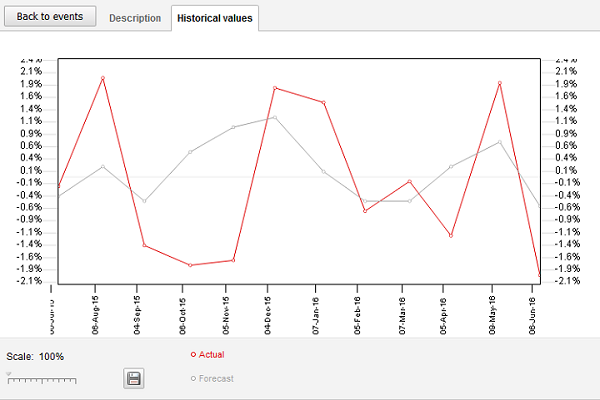
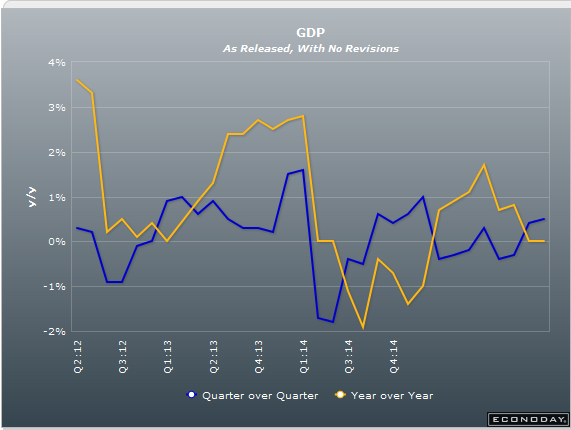
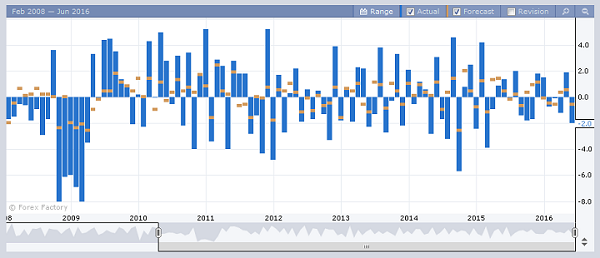
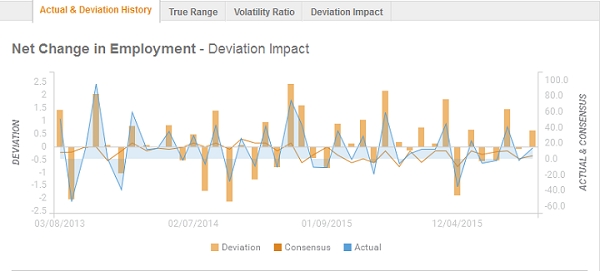
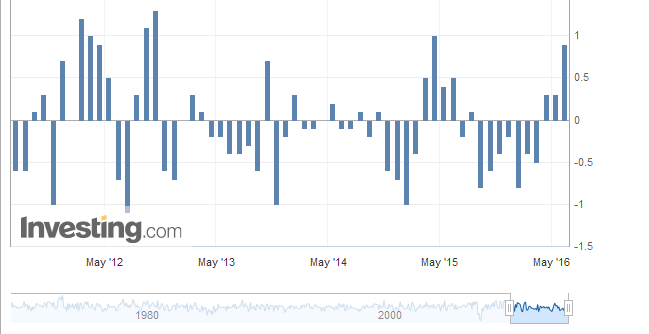
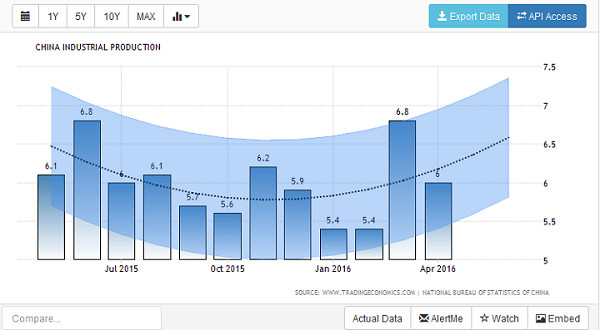
Revisions
Most of the actual estimates from the government bodies are calculated using the partial data. The reason is that the market is always in an urgency to know how the economy is faring. Thus, government institutions perform a delicate balancing act to release the actual data a little earlier. This causes a revised data to be issued later. The sign of the previous and revised data is usually the same. Only the absolute values differ.
When a new data is announced for an indicator, simultaneously, the revised value (corresponding to the previous week or month) for the same economic indicator is released. Most of the economic calendars display such revised information with a different color. There are also calendars which provide both revised and unrevised values for traderâs convenience. The approach of different economic calendars to revised values is explained below.
The only exception is Dukascopy, which does not show the revised values.
Filters
Using a filter, a trader can prioritize the list of events to monitor as per the personal need. Almost all the calendars offer the following three basic filters.
We shall look at the specific filters offered by each of the economic calendars taken here for assessment.
BabyPips.com allows filtering based on currency, impact, and session (London, New York, Tokyo, Sydney). The currency filter offers a selection of 9 currencies (AUD, CAD, CHF, CNY, EUR, GBP, JPY, NZD, and USD). By default, all the currencies, news events, and sessions remain selected. However, âRemember Filtersâ option can be used to display a traderâs choice of currencies and events pertaining to a single or multiple sessions.
Daily FX supports only currency and impact based filtering. It does not offer an event based filter. However, keyword based event search facility is provided. In total, nine currencies are provided in the filter list. They are: USD, GBP, CAD, JPY, AUD, CNY, EUR, CHF, and NZD.
Dukascopy offers currency, impact and event based filter. There is also a provision to perform keyword search. In all, 22 currencies are listed in the currency filter. They are: HUF, ISK, GBP, ZAR, SEK, KRW, CHF, CAD, AUD, PLN, RUB, INR, USD, NZD, TRY, ARS, EUR, BRL, DKK, CNY, JPY, and MXN.
Econoday does not offer country/currency, event or impact based filter. However, they offer the facility to switch between the US and global calendars.
Forex Factory offers currency, impact, and event based filter. There are 9 currencies in the filter: AUD, CAD, CHF, CNY, EUR, GBP, JPY, NZD, and USD.
FXStreet, similar to Investing.com, offers all the three (country, impact and event) filters. The impact filter is denoted as âVolatilityâ. The calendar also offers a keyword based event search facility. There is also a custom date filter. Some of the economic calendars do not allow event based search between two specific dates. This facility overcomes that issue. For example, using the filter and without registration, as shown in the image below, we segregated nonfarm events between May 2015 and August 2015.
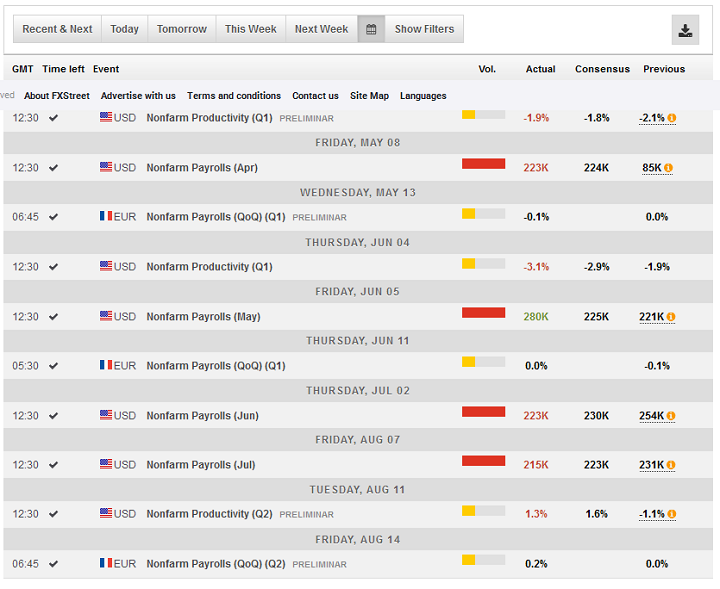
We were unable to perform a similar search using Investing.com (calendar resets to current date). There are 41 countries and one monetary union in the country filter.
Expand the full list of countries
Argentina, Australia, Austria, Belgium, Brazil, Canada, Chile, China, Colombia, Czech Republic, Denmark, European Monetary Union, Finland, France, Germany, Greece, Hong Kong SAR, Hungary, Iceland, India, Indonesia, Ireland, Italy, Japan, Mexico, Netherlands, New Zealand, Norway, Poland, Portugal, Romania, Russia, Singapore, Slovakia, South Africa, South Korea, Spain, Sweden, Switzerland, Turkey, United Kingdom, and United States.
Investing.com offers all the three (country, impact and event) kinds of basic filters. Furthermore, there is also a time based filter to view the actual display time or the time remaining for the announcement. Even event based keyword search is possible. There are 87 countries and one monetary union in the country filter.
Expand the full list of countries
Argentina, Australia, Austria, Bahrain, Belgium,
Trading Economics offers country and impact based filtering. In the country filter, two groups, namely âG20â and âWorldâ are only available for selection. There is no checkbox facility to select a group of countries as per the userâs choice. Other than that, a list of 11 countries (including BRIC) and one monetary region are provided for quick selection. The list of 11 countries and the monetary region is as follows: United States, Euro Area, Japan, United Kingdom, Germany, France, Australia, Canada, China, India, Brazil, and Russia.
Finally, there is also a summation symbol to view the event data of almost any country in the planet (for example Vanuatu).
TeleTrader allows filtering based on event impact, region (North America, Europe, Asia, and Emerging Markets), and country. In all, 51 countries and one monetary union (eurozone) are provided in the country filter.
Expand the full list of countries
Argentina, Australia, Austria, Bahrain, Belgium, Brazil, Canada, Chile, China, Colombia, Czech Republic, Denmark, Egypt, Estonia, Finland, France, Germany, Greece, HongKong, Hungary, Iceland, India, Indonesia, Ireland, Italy, Japan, Korea, Latvia, Lithuania, Mexico, Netherlands, New Zealand, Norway, Peru, Phillipines, Poland, Portugal, Qatar, Romania, Russian Federation, Singapore, Slovakia, South Africa, Spain, Sweden, Switzerland, Turkey, UAE, UK, and USA.
A trader can also filter the economic events on the basis of the source of information or the nature of information. The categories include central banks, confidence indices, consumption and inflation, economic activity, employment, government, holidays, liquidity and balance, and interest rates.
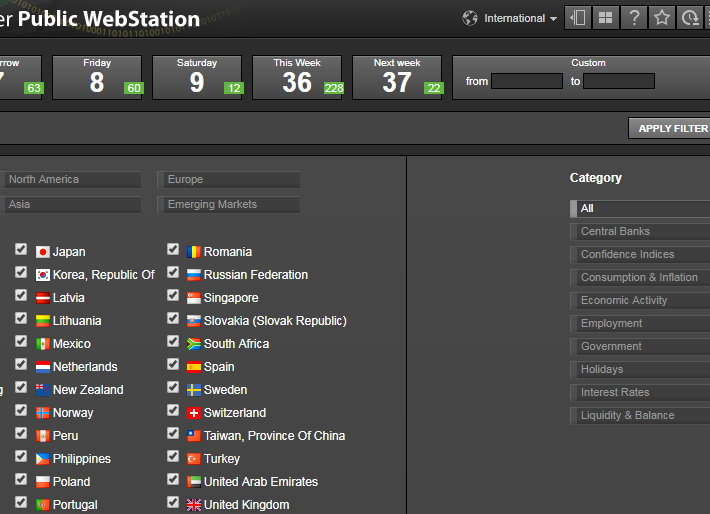
ZuluTrade does not offer an event based filter. Only currency and impact based filtering is possible. The currency filter includes nine fiat currencies (USD, EUR, GBP, JPY, AUD, CAD, NZD, CHF, and CNY) along with a ‘Global’ currency that symbolizes the world economy at large.
Timezone
A trader may or may not be located in the same time zone used by the economic calendar to display the schedule of economic announcements. Thus, it is a necessity for the Forex calendars to display their active time zone or allow synchronization of the server time with the computerâs clock. The economic calendars tackle the issue in the following manner.
Time Browsing
Traders will have a need to browse through past economic data or look at the future schedule of events for a variety of reasons. Thus, every economic calendar strives to offer such a facility, albeit in a different manner.
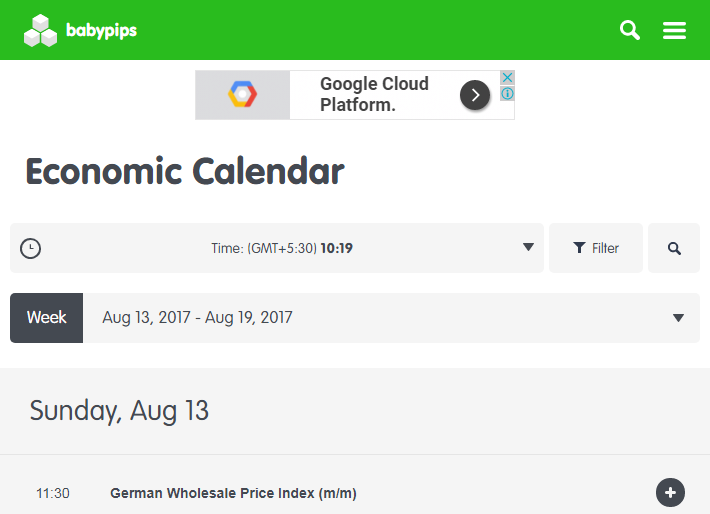
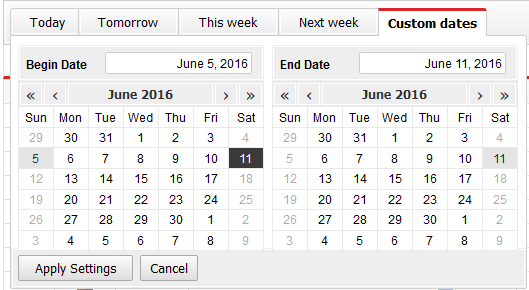
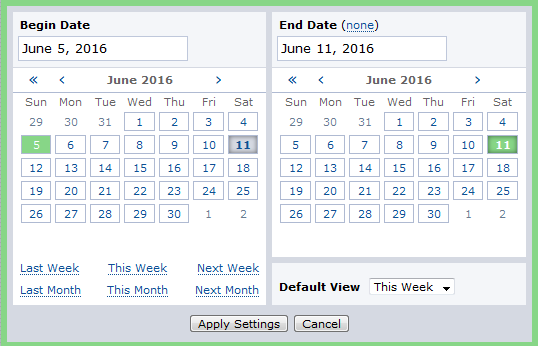
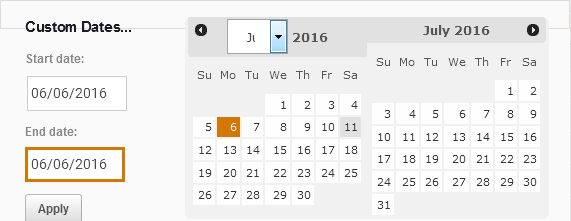
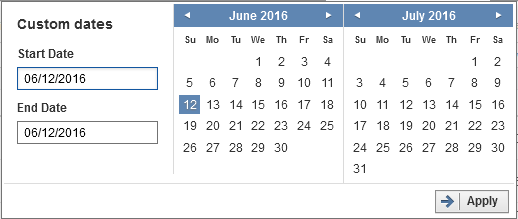

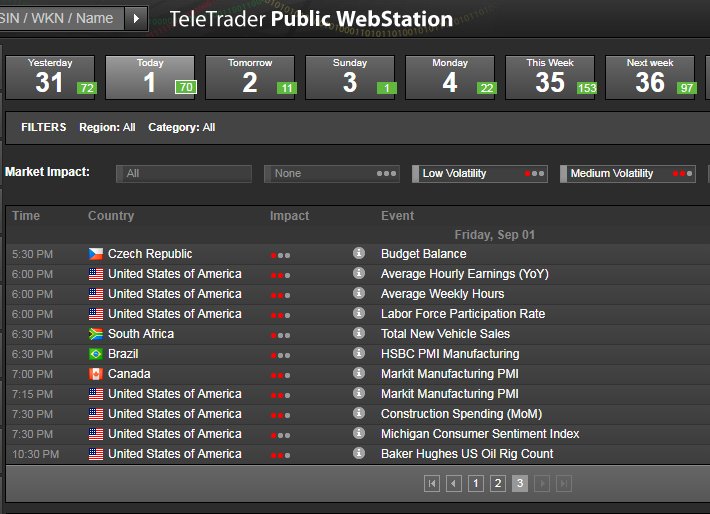
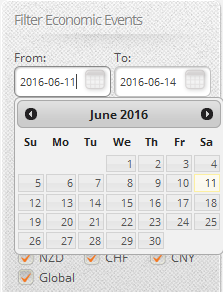
Week Beginning
There are only two economic calendars that use Monday as the starting day of a week. They are Econoday and Dukascopy. ZuluTrade does not have a weekly view. In the case of Forex Factory, a user can set the first day of a week as per his choice and save it to the cookies. Registered users can save the settings through their profile manager. The rest of the researched websites (except TeleTrader) use Sunday as the first day of a week. Unlike other economic calendars, TeleTrader always uses the previous calendar date to list out the schedule of economic events.
BabyPips.com is not a
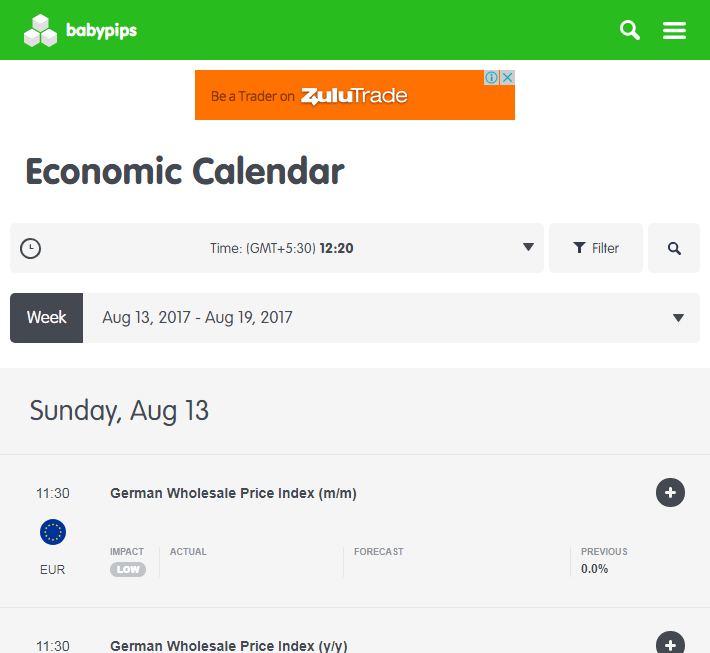
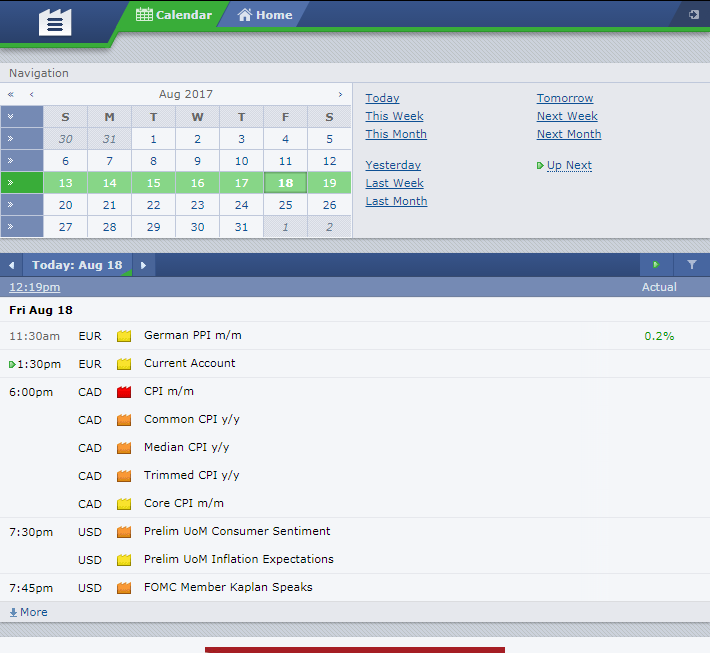
Many a times, traders will have a need to check the event announcements while traveling. Thus, a
BabyPips.com
BabyPips.com is a responsive mobile friendly site with a score of 99% from RankWatch. It has a mobile viewport installed, and uses an easily readable text size. The mobile page does not use incompatible plugins and the content is not wider than the screen. However, the links are placed close to each other.
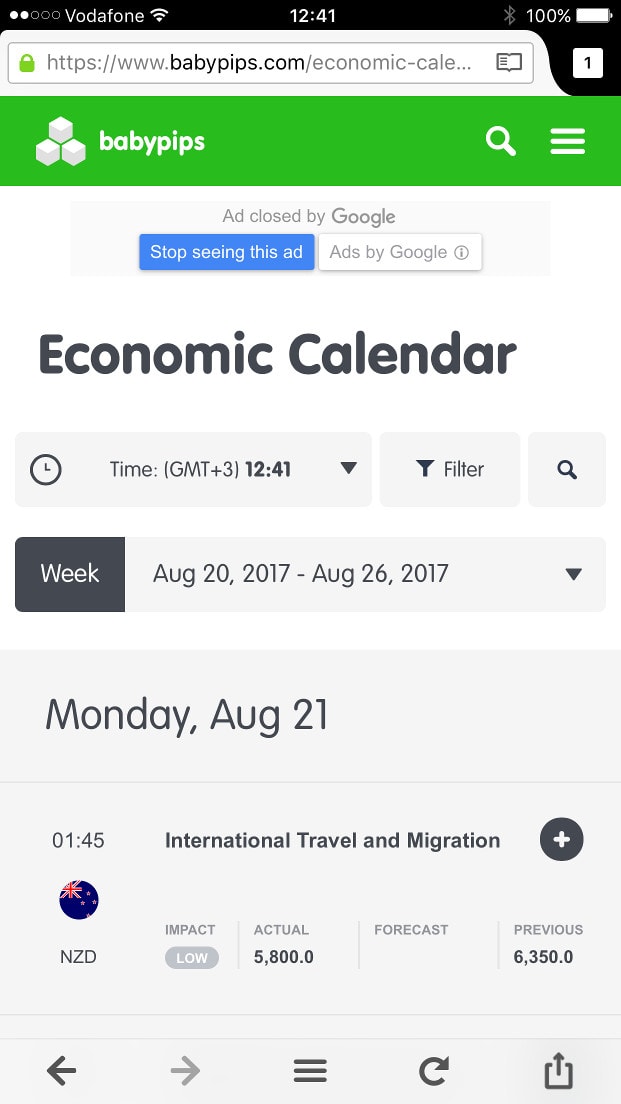
BabyPips.com no longer offers an app for iOS and Android phones. The last official update, issued in May 2016, states that they will not update the app for the new releases of iOS and Android devices as the company behind the Forum Runner software has discontinued development of the Forum Runner app.
DailyFX
Offers a
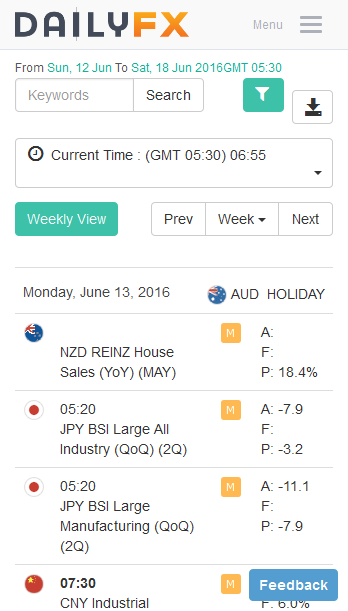
The biggest drawback of DailyFX’ mobile version is that it does not offer the slider for time browsing. All other facilities, including the data (actual, forecast, previous) are presented in a simple and easy to read format. Similar to the desktop version, the mobile webpage does not offer any charts.
Dukascopy
It manages to remain in the list of mobile friendly websites with a score of just 80% from RankWatch. Dukascopy does not have an app in its own name. However, registered members of Dukascopy can use the app developed by Swiss Forex for Android and iOS devices. Some of the features offered by the app are horizontal mode scrolling charts, market sentiment, pattern radar, commitment of traders and Dukascopy TV.
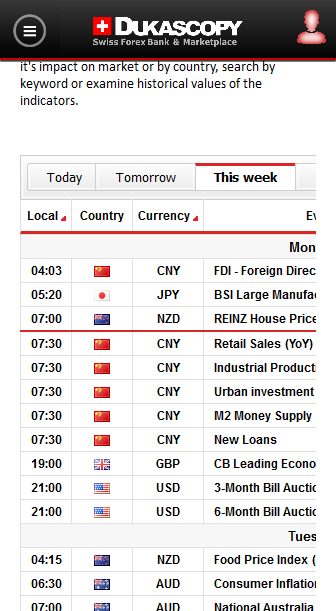
Similar to BabyPips.com, a lot of scrolling is needed to select and study a particular event in the calendar. However, the mobile page offers a better scalable historic chart. The calendar does not look congested.
Econoday
It is certainly a mobile friendly site with a score of 96% from RankWatch. Interestingly, Google Webmaster Tools does not consider it as mobile friendly as the content is wider than the screen. Offers only iOS app for iPhone/iPad. Their official website does not mention about Android app. The app is available free only for the subscribers of MyEconoday.
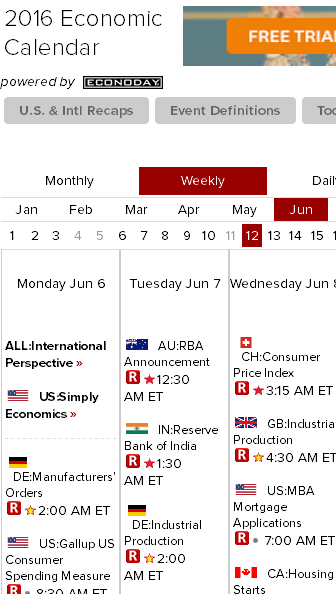
The mobile page loads very quickly relative to other calendars. All the facilities provided in the desktop version are available in the mobile version as well. Furthermore, time browsing can be done quickly. However, a little bit of scrolling is required to study the calendar.
MyEconoday offers its iOS version of the app free for the first 15 days. After that, a subscription, beginning at $9.99 per month, is required to receive the event data. The economic calendar resembles that of the desktop version. Event data and description is made available.
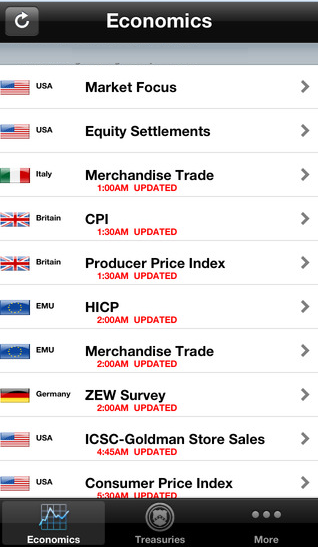
Pros: The event data can be customized. Furthermore, there is an
Cons: Does not offer Android version and subscription is required.
Forex Factory
It is a
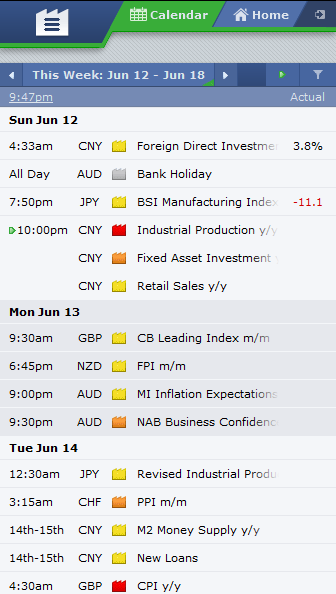
In the mobile version, when a user looks at the screen only the actual values pertaining to an event can be seen. Only by clicking an event, all three values (actual, forecast, and previous) can be studied. In the same manner, the chart and description of the event can be accessed. An exit tab provided with the chart and event description enables going back to the main screen in an easy manner.
Forex Factory offers an app with basic features. Both impact and currency based filter are available. Even local time can be set.
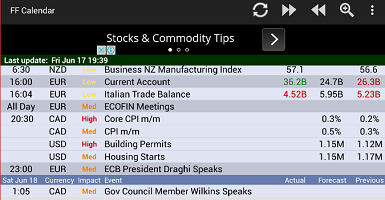
Pros: The app offers zooming facility. There is also a facility to fast forward/backward the event date.
Cons: It does not offer charts. Has no
FXStreet
Offers a mobile version of the website and provides a
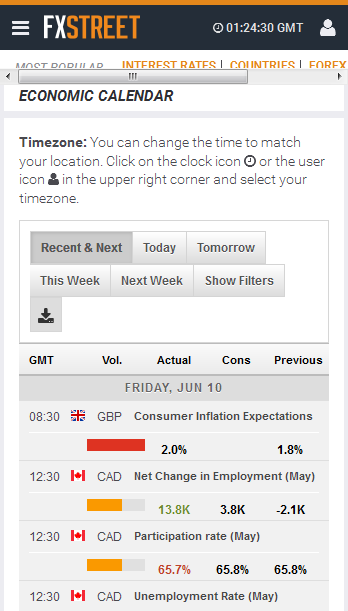
Similar to Investing.com, the mobile version of the calendar enables users to easily shift from one section to the other using the open menu. However, time browsing is not possible. The historic chart looks clear, but the tabs (true range, volatility ratio, and deviation impact) are organized in a congested manner.
The app offered by FXStreet has a simple layout. The settings menu, provided on the right side of the screen, enable subscription to news updates and changing to local time zone. Two other icons, one for the news and another for the calendar, is provided in the same row where the settings is located.
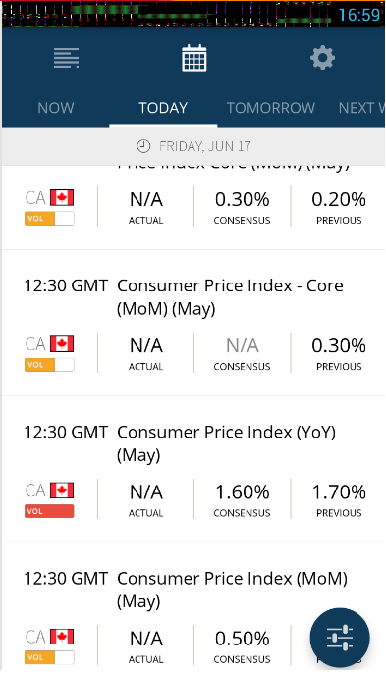
Pros: The font size of event data is bigger. Thus, users will find it very comfortable to read. Filter menu on the lower side of the screen allows easy segregation of requisite event data. Has
Cons: The news update is not currently functioning. The website owners have put a message (without any definite time frame) saying that news pagination and stability improvements are currently carried out. The time zone synchronization does not work properly. Time browsing is limited to yesterday, today, tomorrow and the next week.
Investing.com
The mobile version of the website offers important sections (news, economic calendar and market quotes) of the desktop website. RankWatch gives the website a rating of 99%, but warns that links are too close to each other. Investing.com also offers freely downloadable Android and iOS app. The Android app has been downloaded more than a million times and carries a rating of 4.6.
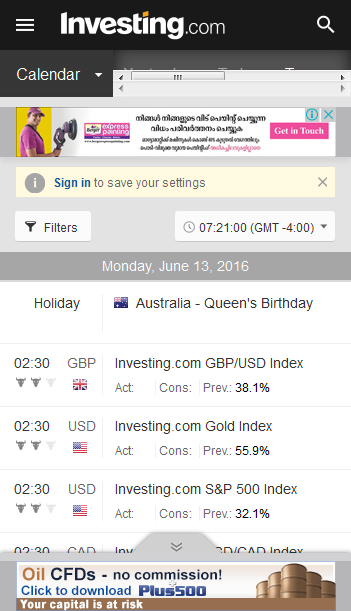
The mobile version of the website is well organized and easy to browse. The open menu allows users to quickly move between different sections (news, calendar, analysis, portfolio, earnings, top brokers, etc.) of the website without any difficulty. Furthermore, the line spacing ensures comfortable reading without any strain to the eyes. Even filtering of data is possible. The graphs have a neat appearance. They could have avoided the
Investing.com covers multiple financial markets (stock, commodities, and Forex) in a single Android app. Data pertaining to more than 40,000 assets traded in 70 exchanges are offered. As of now, the app is offered in 14 languages. Country and impact filter is available. Keyword event search is also possible. The app has
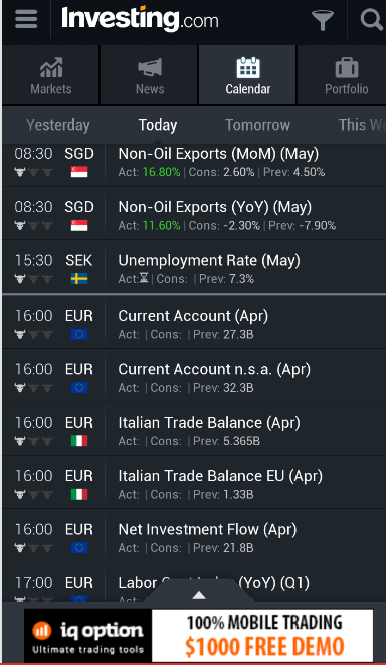
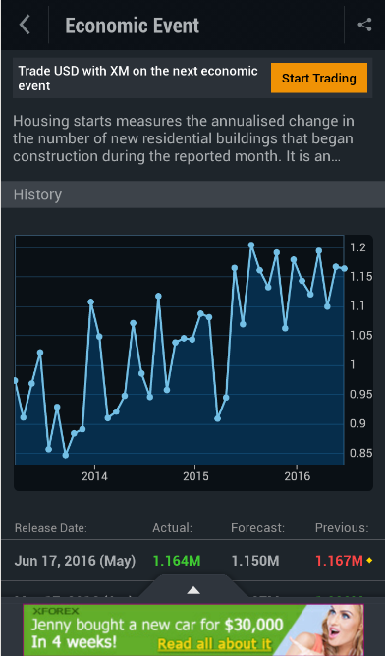
Pros: The economic calendar provides data and charts on a
Cons: The app is little slower in providing the event updates. Large ads are shown during loading. Time browsing facility is restricted to yesterday, today, tomorrow and the running week.
Latest feature: The app provides alerts based on price, percentage change and volume.
Trading Economics
The site is
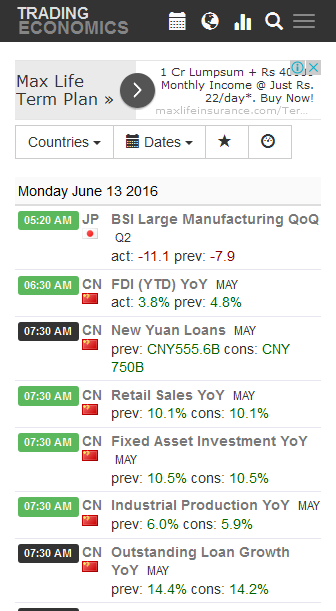
The mobile version uses a good color combination to represent the impact of events on the market. However, when a user clicks to read further details about the event, it opens the page in a new tab. Furthermore, the graph is presented in an extremely compressed manner. It is of practically little use to a trader. Filters, however, can be applied easily.
TeleTrader
TeleTrader is not a responsive mobile friendly site, according to RankWatch. The website receives a score of only 61%. RankWatch points out that the contents of TeleTrader are wider than the screen and the links are too close. On the positive side, the mobile viewport is set, text is big enough to read, and the website does not use incompatible plugins.
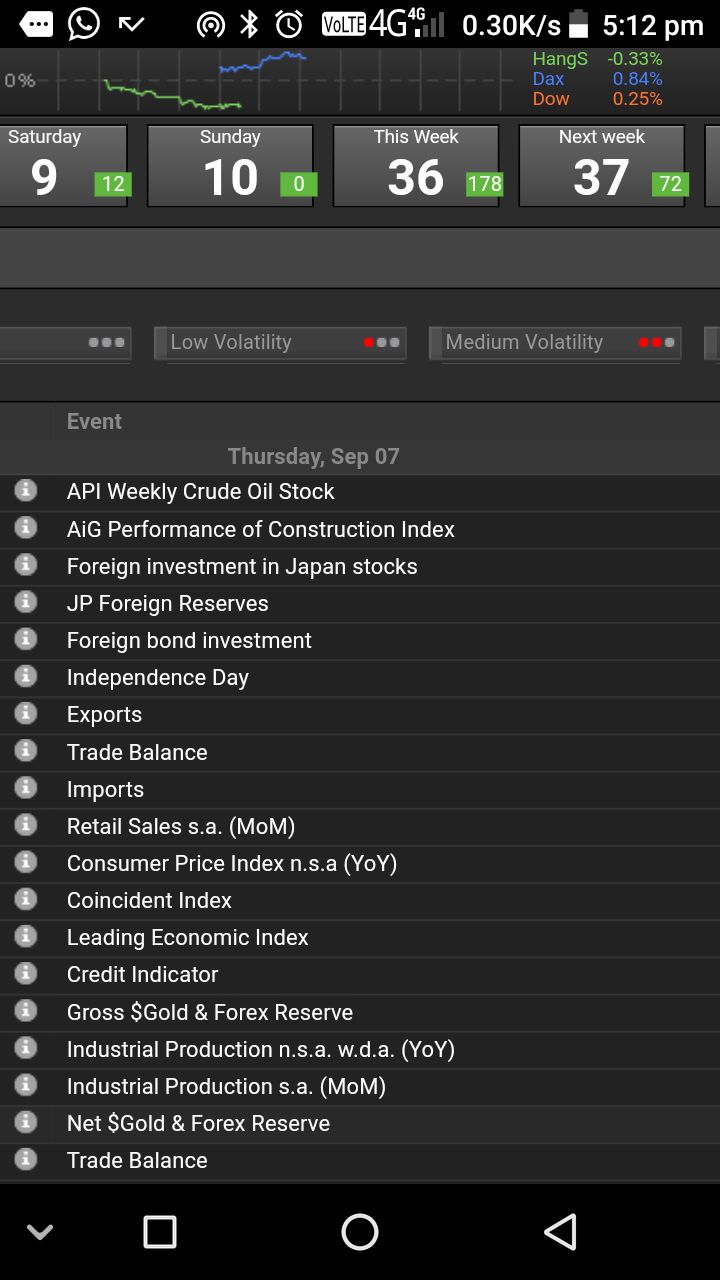
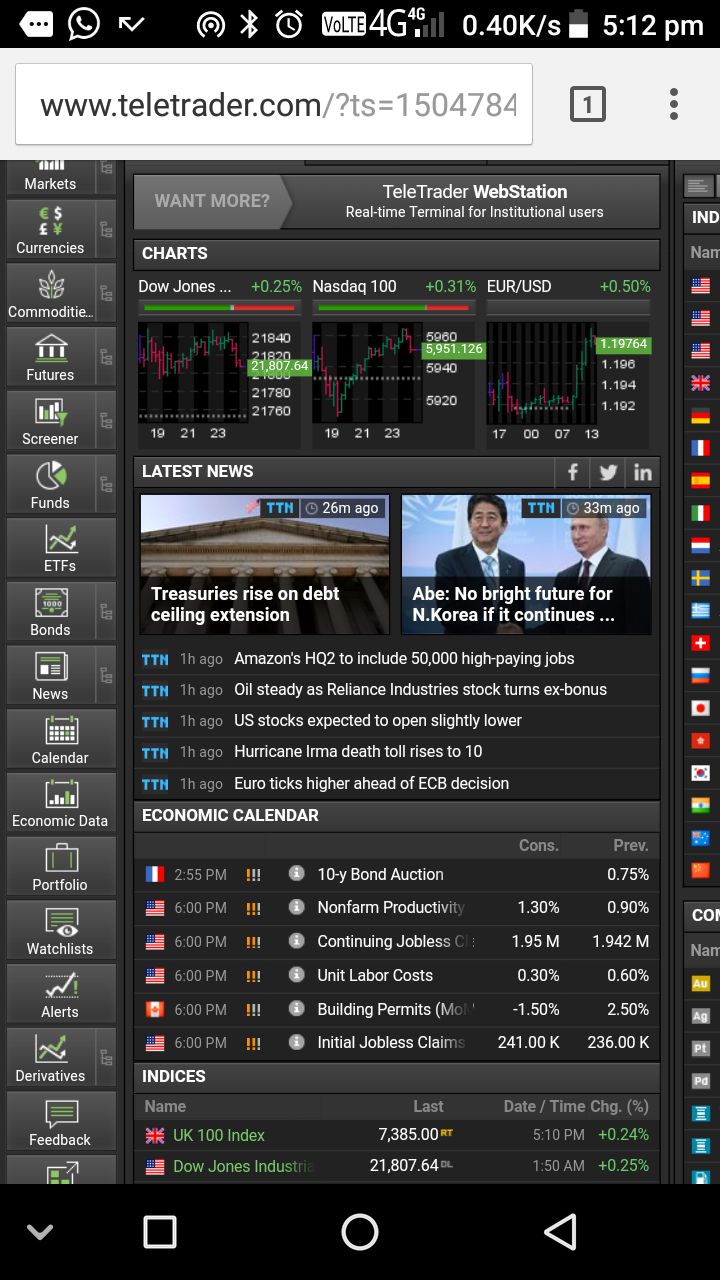
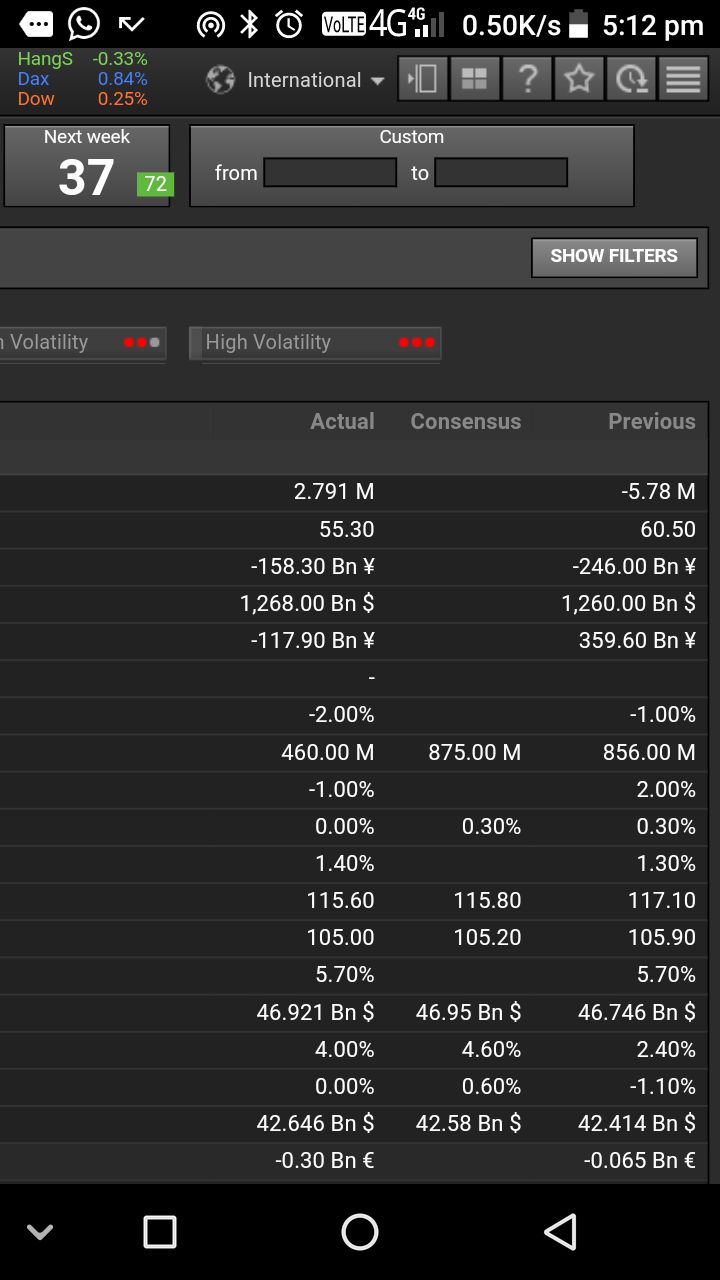
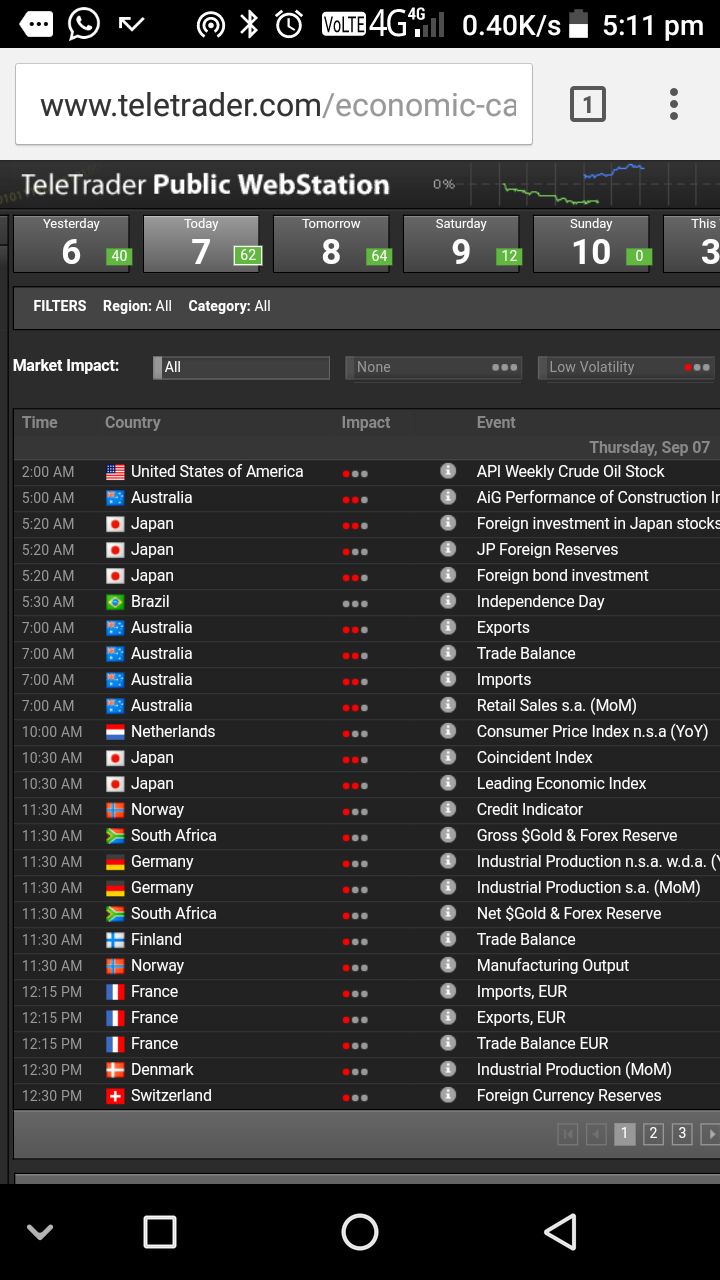
TeleTrader offers Android and iOS apps that can be downloaded freely from the App Store or Google play.
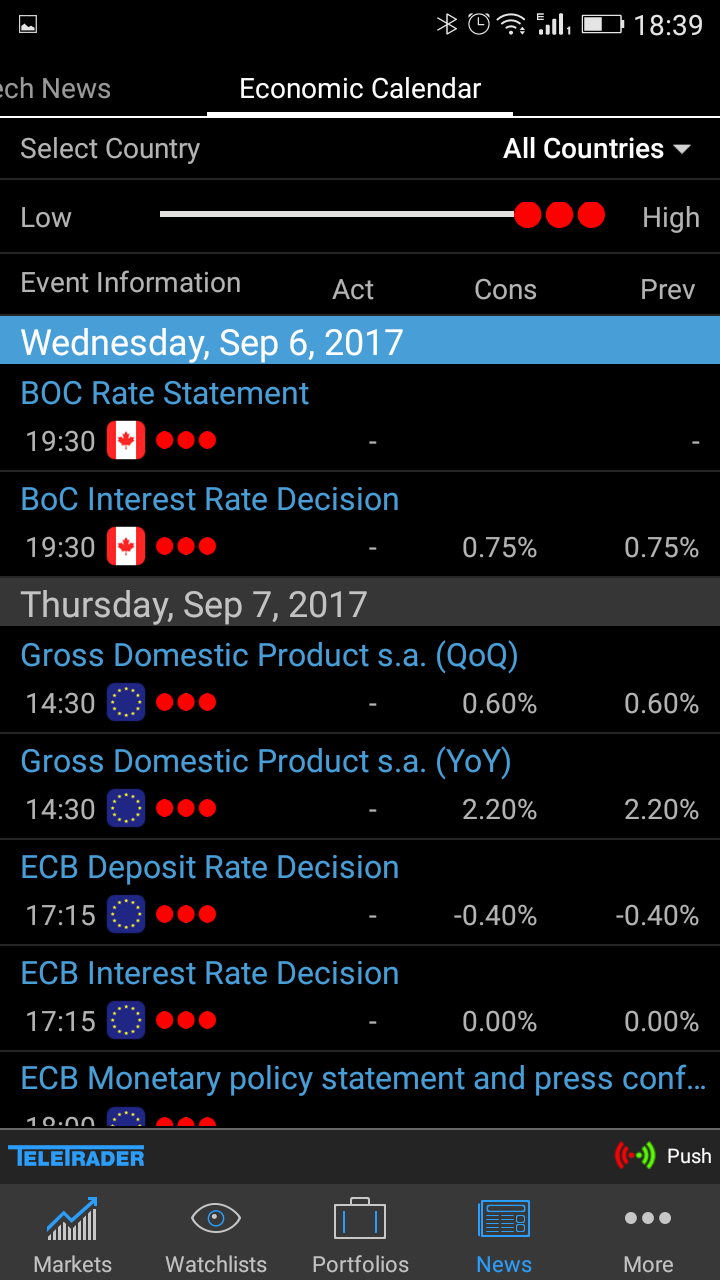
It allows a user to narrow down the search based on countries. In all, 11 countries (USA, UK, Japan, Australia, Germany, Canada, China, New Zealand, Italy, Korea, and Switzerland) and one economic union (eurozone) are listed.
The list of events can also be narrowed based on impact on the Forex market. A brief explanation of the indicator and the link to the data source can be accessed by tapping the event data. Additionally, the app allows a user to set a watchlist, create portfolios, and track multiple financial markets. The app also offers a search facility, currency converter, and screener. It allows viewing the calendar in 13 languages. News notifications can be enabled.
Pros: Practically all the financial markets can be tracked. Offers a
Cons: Sometimes we may feel that too much of information is offered.
ZuluTrade
It is also a mobile friendly website with a score of 99%. Close links seem to be the issue with this one as well. Offers app for Apple, Android phones, and Windows (version 8, 8.1 and 10) based phones. The Android and Windows app carry a rating of 4.1 and 4.6 respectively.
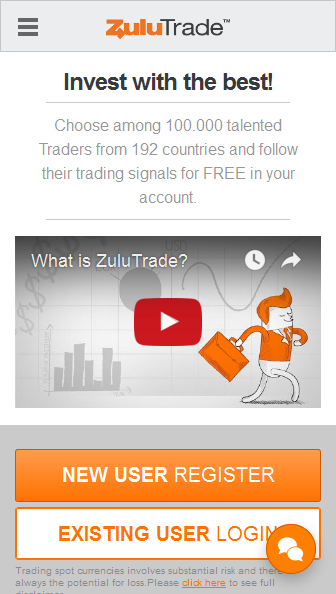
The mobile version enables browsing the list of suitable traders and picking a suitable one to follow. However, registration is required to access the content. Traders unwilling to register can switch to the normal version of the website.
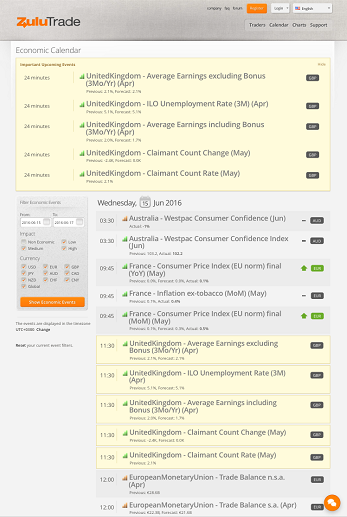
The normal version is a replica of the desktop version. It shows the economic calendar without any restrictions. However, event search for long time periods will not be displayed completely due to restrictions on the page length.
ZuluTrade offers an app similar to the desktop version. The main menu facilitates switching to the economic calendar. There is also a âTodayâ button at the top of the calendar screen which enables a trader to quickly go back to the highlighted list of upcoming events. Both currency and impact filter is available.
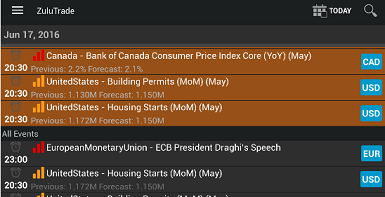
Pros: Alerts (1 minute and 5 minutes before the event) can be set using the alarm icon provided above the time of release of event data.
Cons: The event data is provided in grey color. Users would find it difficult to study quickly. Need to tap the event data for better view in a
Investing.com, Econoday, TeleTrader, and ZuluTrade should be the website of choice for a trader using mobile frequently to track economic events. Forex Factory deserves the next place. Dukascopy should be the last choice. BabyPips is of no use to a professional trader.
Delays
A trader having access to fast economic data will naturally have an early entry advantage in the market. The ten websites, which we have taken for research, do not present the data to a user at the same time. Some of them are little earlier than others.
FXStreet and Trading Economics provide faster event updates, compared to other websites taken for study. ZuluTrade follows them closely. Since Forex Factory, Dukascopy and TeleTrader do not provide the
Notification
None of the economic calendars offer sound based event notifications. Other alerts offered by the calendars is described below.
Loading Speed
The economic calendar has value only if it loads quickly. In this regard, the performance of all the ten researched web sites is assessed using the service of WebPageTest. The websites were tested using six different geographical locations: US East Coast (Dulles, VA, USA), US West Coast (San Jose, CA, USA), South America (Buenos Aires, Argentina), Europe (London, UK), Asia (Tokyo, Japan) and Oceania (Sydney, Australia). Using Firefox browser, the time taken for each website to load (first view, in seconds) from the six locations and the average load time is summarized in the table below.
From the above table, it can be understood that Econoday leads all other websites as far as the calendar access speed is concerned. Forex Factory, which takes the second position with an average load time of about 5 seconds is rather slow in Asia and Oceania. Investing.com does not fare well in any of the locations. Maybe they should optimize their calendar page layout and remove some bloated scripts. Those living on the East Coast may appreciate the response time of Trading Economics. ZuluTrade could be another good choice for the US East Coast traders. On the other hand, West Coast dwellers would find Forex Factory a better choice after Econoday when it comes to calendar loading time. TeleTrader is not too bad in Europe.
Number of Events
A news trader will be naturally inclined to look for a calendar which offers the maximum number of events. While the economic calendars do not miss out any major currency, they curtail the number of news events listed in their economic calendar. Since there is no provision for a user to add a news event to an economic calendar, it becomes all the more important to select an economic calendar that offers the maximum number of news events relevant to a news trader. In this regard, we have calculated the number of events provided by the 10 calendars for the four major currencies (EUR, JPY, GBP, and USD). The calendar month used for assessing the completeness of an economic calendar is August 2017.
The definite leader in providing the maximum amount of economic data is DailyFX. On the other hand, BabyPips.com, Forex Factory, and Econoday certainly seem to suit only those traders who focus on major news events.
Forecast Accuracy and Similarities
Quite often a trader will come across differences in the event forecast data released by two different calendars. Usually, there will be a difference only in the absolute value of an event forecast data. The sign preceding the absolute value will not contradict. The use of different primary data source contributes to the difference in the forecast value.
To assess the forecast accuracy of different calendars, we used the âUS
2017
There are two rows for Trading Economics in the table above. Their calendar offers two different values for each prediction — Consensus forecast (similar to most other calendars), and an
Translations
A Citi Groupâs survey conducted in 2014 estimated that there are about 4 million traders worldwide. Of those, only 150,000 traders reside in the USA. Almost 1.4 million traders live in Europe, while 1.6 million traders live in Asia. Thus, it is clear that most of the traders do not have English as their native language. To assist traders in reading through economic calendars, top rated Forex related web sites offer translations to other languages. Let us check, how far it is the case with the calendars we have taken for research.
Trading Economics leads the fray. It is closely followed by Investing.com and FXStreet. ZuluTrade does not offer translation in totality. So, it stands behind others.
Extra Features
Some calendars offer extra features which deserve to be mentioned. The list compiles the additional features, if any, in each calendar being researched.
BabyPips.com — the âDayâ tab facility provided above the calendar slider enables a trader to quickly revert back to the current date.
DailyFX — provides a Central bank calendar. All events have the country ISO code affixed to it. That makes it easy for keyword search (in case there is a doubt about the exact name of the event).
Econoday — offers a separate link for event definitions. It allows a trader to quickly refer to the details regarding a particular event. While most of the professional traders will have no hesitation to explain what a “nonfarm payrolls” data is all about, it will not be so when there is a query about “Gallup good jobs rate”. The event definitions would be useful precisely in such a scenario.
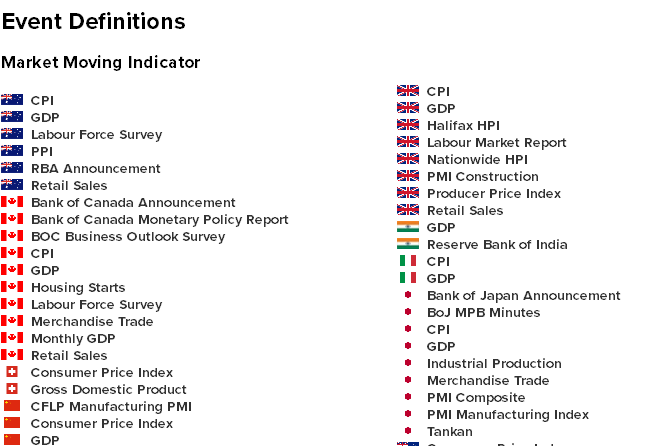
Forex Factory — displays the Central bank rates in a
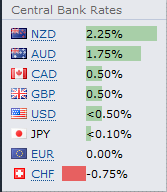
FXStreet — offers deviation impact study. Using the facility, a trader can understand whether an economic data surprised the market in the past, compared to the expectations. The explanation of the chart (as provided by the website) is provided as a screen shot underneath.
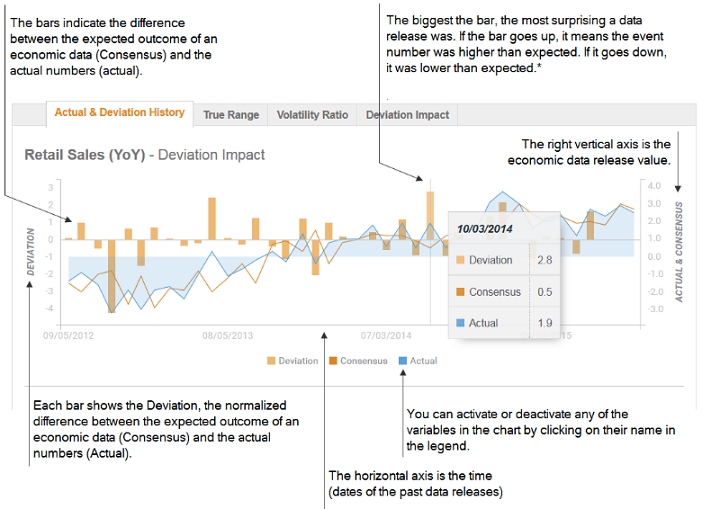
The calendar also offers true range, volatility ratio, and deviation impact charts for currency pairs such as EUR/USD, USD/JPY, GBP/USD, AUD/USD, and USD/CAD. The calendar also segregates the concluded events by a tick mark.
Investing.com — offers the facility to monitor the time remaining for the next news announcement. There is also a quick link to the holiday calendar.
Trading Economics — allows creation of custom watch lists. Chart based comparison of an event with another (selective list) is also possible.
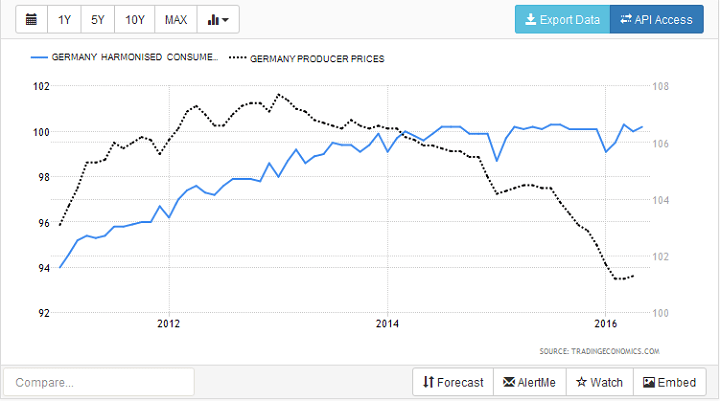
TeleTrader — using the left block button provided at the top right corner of the website, a trader can keep himself abreast of the latest geopolitical news across the globe. The button can also be used to hide the news and view only the economic calendar. The search facility on the top left corner of the website can be used to track a single currency pair and to study all the relevant details: weekly/monthly/quarterly/5-year performance, monthly/quarterly/yearly high and low, average weekly/monthly/semiannual/annual price and volume, monthly/semiannual/annual/3-year volatility, rates quoted by multiple brokers, charts with timeframe ranging from intraday to 10 year, and the latest news pertaining to the currency pair.
A user can also search based on a combination of currency and region. TeleTrader also provides an ocean of details pertaining to other financial markets. The data can be accessed through the tabs provided on the
ZuluTrade — highlights the next event for which the data will be announced, and additionally displays it above the event list.

Exporting and Printing
If you are a trader with a habit of using a clipboard to track economic events, then a print friendly economic calendar would be very useful. At the least, there should be a facility to export the economic calendar to any other print friendly format.
Summary
Use BabyPips.com if:
reverting back to the current date.
Use DailyFX if:
Use Dukascopy if:
Use Econoday if:
Use Forex Factory if:
Use FXStreet if:
Use Investing.com if:
Use Trading Economics if:
Use TeleTrader if:
Use ZuluTrade if:
That is all for our 2016–2017 review of the top economic calendars. The research should help you in choosing the right Forex calendar for your analytical needs. Of course, you can always use not just one but several calendars that you have liked.
Tell us how you use Forex calendars in your trading and which calendar is your favorite one!